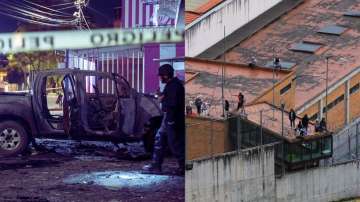Ecuador: 57 guards who were held hostage in prisons by criminal gang released after 24 hours
Security analysts said the chain of events, which took place three weeks after the slaying of presidential candidate Fernando Villavicencio was a “systematic and planned” attack that had shown the state was ineffective in preventing violence.

Ecuadorian authorities announced that 50 guards and seven police officers who were taken hostage for more than a day were freed on Friday. The government described the shocking incident as a response by criminal groups to its efforts to regain control of several large correctional facilities in the South American country.
The country’s corrections system, the National Service for Attention to Persons Deprived of Liberty, said in a statement that the 57 law enforcement officers —who were held in six different prisons — are safe, but it didn’t offer details about how they were released.
Early on Friday, criminal groups in Ecuador used explosives to damage a bridge, the latest in a series of attacks this week. Nobody was injured in the explosion. Government officials have described the violent acts as the work of criminal gangs with members in prisons responding to efforts by authorities to retake control of several penitentiaries by relocating inmates, seizing weapons and other steps.
4 car bombs exploded in 48 hours
Four car bombs and three explosive devices went off across the country in less than 48 hours. The latest explosion with dynamite happened early Friday on a bridge linking two cities in the coastal province of El Oro, National Police commander Luis García told The Associated Press.
Hours earlier, a domestic gas tank with wads of dynamite attached exploded under a different bridge in Napo province of Napo, located within Ecuador’s portion of the Amazon rainforest. Consuelo Orellana, the governor of Azuay province, reported early Friday that 44 of the hostages at a prison in the city of Cuenca had been released. The country’s correction system said later that all 57 were freed.
Security analyst Daniel Pontón said the chain of events, which took place three weeks after the slaying of presidential candidate Fernando Villavicencio was a “systematic and planned” attack that had shown the state was ineffective in preventing violence.
“What does state intelligence do in these situations? It has not done anything, although the orders (for explosions) surely come from the prisons through cellphones,” he said. Pontón thinks the strikes are intended to generate fear among the population and influence politics. Ecuador is set to elect a president in an Oct. 15 runoff vote.
“The issue is that we are seeing an escalation of the problem, and given the level of incompetence of the state, later we can expect attacks against the population,” Pontón said. “It is a predictable scenario that would be terrible.”
The series of explosions began Wednesday night, when a car bomb exploded in Quito, Ecuador’s capital, in an area where an office of the country’s corrections system was previously located. Two other car bombs then went off in El Oro province, which is in the country’s southwest. Another vehicle in Quito exploded Thursday, this one outside the corrections system’s current offices. An explosive device also went off in Cuenca, located in southern Ecuador’s Andes mountains. A judge ordered six people suspected of involvement in the capital blasts kept in custody while an investigation continued.
Spike in violence
Ecuadorian authorities attribute a spike in violence over the past three years to a power vacuum triggered by the 2020 killing of Jorge Zambrano, alias “Rasquiña” or “JL,” the leader of the local Los Choneros gang.
Los Choneros and similar groups linked to Mexican and Colombian cartels are fighting over drug-trafficking routes and control of territory, including within detention facilities, where at least 400 inmates have died since 2021, according to authorities.
Gang members carry out contract killings, run extortion operations, move and sell drugs, and rule the prisons. Villavicencio, the presidential candidate, had a famously tough stance on organized crime and corruption. He was killed on August 9 at the end of a political rally in Quito despite having a security detail that included police and bodyguards.
He had accused Los Choneros and its imprisoned current leader, Adolfo Macías, alias “Fito,” of threatening him and his campaign team days before the assassination. Authorities detained six Colombian men in connection with Villavicencio’s slaying.
(With inputs from agency)